domingo, 26 de julio de 2015
EIGHT SHORT BREAKS-:-a short 8mm film...GATO HEROI
EIGHT SHORT BREAKS-:-a short 8mm film from No pain in Dream on Vimeo.
Eight Short Breaks is a short film entierly shot in super 8 mm.
A contemporary escape from Viet nam, to Brazil, France, Australia and New York City.
A deep vision of the surfboard culture.
La historia de una camiseta. MIKI DORA... http://elveranosinfin.blogspot.com.es
La historia de una camiseta.
Aunque
más que la historia de una camiseta, es la historia de LA camiseta.
Aquella con la que el mítico Micky Dora participó en el Duke Kahanamoku
Invitational Surfing Champioship de 1967, en Sunset Beach, Hawaii.
La
cosa empieza con un tipo llamado Jeff Hight y su novia en el Malibú de
1968. A Jeff, a partir de ahora, le llamaremos El Afortunado, ya
entenderéis por qué. Una mañana de ese año estaban los dos en la playa
tomando el sol y viendo un poco de surf cuando de repente llega Micky
Dora, se cambia al lado de ellos, se acerca y les dice textualmete: "Hey
kid, watch my stuff for me, will ya?", algo así como: "Quillo, échale
un ojo a mis cosas, ¿vale?". El Afortunado y su chica asienten con la
boca abierta mientras Micky se va al agua. Los dos se quedan flipando
por estar guardándole las cosas a "Da Cat", quien por aquella época ya
era lo más parecido a un héroe para los surfistas californianos.
El
caso es que Micky pierde la noción del tiempo en el agua -como todo
buen surfista- y cuando sale se da cuenta de que ha pasado más de medio
día. Apurado, se acerca al lugar donde dejó sus cosas y allí estaban,
aún pasmados, nuestros dos amigos. Tras darles las gracias por haber
esperado tanto tiempo, Micky coge LA camiseta, se la lanza al Afortunado
y le dice: "Keep it!", "Pa' ti". No puedo ni imaginar los dos
lagrimones que le caerían por las mejillas a ese chaval ante semejante
regalo.
Tras
guardarla en su casa durante años, nuestro amigo El Afortunado, en un
arranque de humanidad, pensó que la camiseta debería estar a la vista de
todos. Contactó con Cary Weiss, uno de los mayores coleccionistas de
surf de Estados Unidos, y juntos acordaron que el mejor sitio para este
pedacito de historia del surf era el restaurante "Duke´s" de Malibú,
donde descansa en una de sus paredes desde 2004.
Así
que ya sabéis, estad siempre dispuestos a vigilar las cosas de la gente
en la playa. Quizás algún día os lo pida una legenda del surf.
sábado, 25 de julio de 2015
Tom Morey: "The term 'bodyboarder' sucks"..SURFERS TODAY.COM
- 23 June 2015 | Bodyboarding

Meet Mr. Tom Morey, the inventor of bodyboarding. Or, has he prefers to call it, "boogieboarding." The founder of Morey Boogie says, "the term 'bodyboarder' sucks. Sounds like a board they'd use to slide a corpse down into a body bag." His life is an adventure. And he still is a very busy man.
Tom Morey is the ultimate surfing inventor. In an exclusive interview with SurferToday.com, the Detroit-born wave rider dissects the innovations he introduced to the water sports industry, and his personal perspectives on the present and future of boogieboarding.By the way, do you know who was the first woman to ride a bodyboard? Tom Morey will tell you.
When did you have your first contact with the waves?
In 1942, my dad Howard moved my mom Grace, my 13-year-old sister Junie and seven-year-old me, from Detroit to California.
We settled in Merced for a year and a half, when they bought a combination auto court, trailer park, gas station and general store, on Highway 99, for about $15,000, which he'd saved up by selling vacuum cleaners and sewing machines.
They sold it for a good profit and then moved to Laguna Beach, California, where dad went fishing for a couple years. Then he and mom sold Laguna itself, Morey real estate (1946-1959).
The year 1944 saw eight-year-old Tom bodysurfing (literally) straight in, riding atop Howard's freckled English-Irish back, holding on to his shoulders.
At 23, you were working at Douglas Aircraft as an engineer? Why did you decide to quit and found Tom Morey Surfboards six years later?
Because I'd learned to patch my own surfboard - it gave me plastic fabrication resume experience - and I had built a honeycomb-Fiberglas surfboard (which failed) using Douglas Aircomb, and had a Math degree from a major university (University of Southern California), I was able through my Douglas contacts to sell my way into an engineering position there. It was called the "Plastics" division, now "Composites."
While at Douglas, I came up with a few minor innovations, but I could see that the guy two desks in front of me with spilled catch-up on his tie, was where I'd be if I stayed for ten more years. So, I job hunted twice over the next three years and landed improved aerospace positions each time.
Meanwhile, I was surfing Trestles, Cotton's, Salt Creek, Malibu, Rincon and, to my amazement, I had developed quite a name for myself. Severson put me on the cover of Surfer Magazine, in 1956 or 1957.
By then, I'd made key surfboard manufacturing contacts and had conceived what could become a practical removable skeg system.
Also, being a sponsored rider for Goddard, then Sweet, Con, Velzy-Jacobs and finally Dewey Weber, each of their boards had been one disappointment after another. All great board builders, but none provided either the feel I wanted or the performance I sensed was possible.
By 1957, I had built and sold half dozen Morey boards in my garage. So I took a chance, borrowed $5000 - which in those days was like $75,000 today - and opened a surf shop in Ventura.
A town of 100,000, far enough from any existing board maker that I was fairly certain I could make a go of it. And right down the road from Rincon, California's premier winter spot.
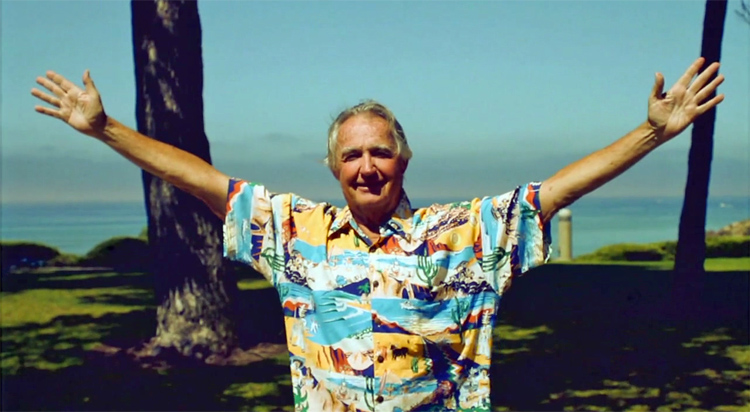
What were your most relevant innovations in surfboard design?
a) The concave nose pocket (1954);
b) The wing-tipped nose (1955);
c) Use of hard down rear rails on regular sized and shorter boards (1956);
d) A practical removable skeg system using polyethylene shear pins that I created and Dewey named "The Wonder Bolt". This bolt gave practicality to removable skegs and also made the Morey-Pope Trisect possible;
e) A unique bolt that was threaded into the front or rear of a skeg. The bolt head was large and had six holes drilled radially into it. It also had a large "V" snapped dimple in its head. You'd screw the bolt into the fin all the way, insert the skeg, and then unscrew the bolt until it was seated bearing firmly against its male counterpart resin cast in the skeg box.
f) Built the first surfboard with multiple skeg boxes across the rear;
g) Engineering how to build and align bisected and trisected surfboards.
h) The original W.A.V.E. fin box featured a tapered fit, plus front and rear hold down bolts so that interchangeable skegs of all kinds could be securely fastened in;
i) A liberal area of overlap for fiberglass lying on top of the box, so the box won't crack all along the seam.
j) The idea of paying royalties to top skeg designers, so that your personal board could be ridden with many different skegs from designers who knew what they were doing. And settling on paying or receiving - I don't care which side I'm on - a 5% royalty. Hobie had implemented the idea of paying Phil to design the Edwards' model. Others had followed suit with models. But the idea of paying designers to fashion skegs for one system, no one had done this.
k) I count this as well: actually following through and scrupulously accounting for royalties, and then making sure everyone was really paid. Otherwise, there's no progress.
Why did you come up with the idea of shaping a bodyboard on the 7th July, 1971?
I had a garage full of materials, flexible waterproof PE foam left over from a precious failed experiment. I needed something to surf, and I was below broke.
I didn't want to borrow a board, and then maybe ding and have to repair it. My wife was eight months pregnant. The surf spot was 30 yards in front of where I was living. What choice did I have?
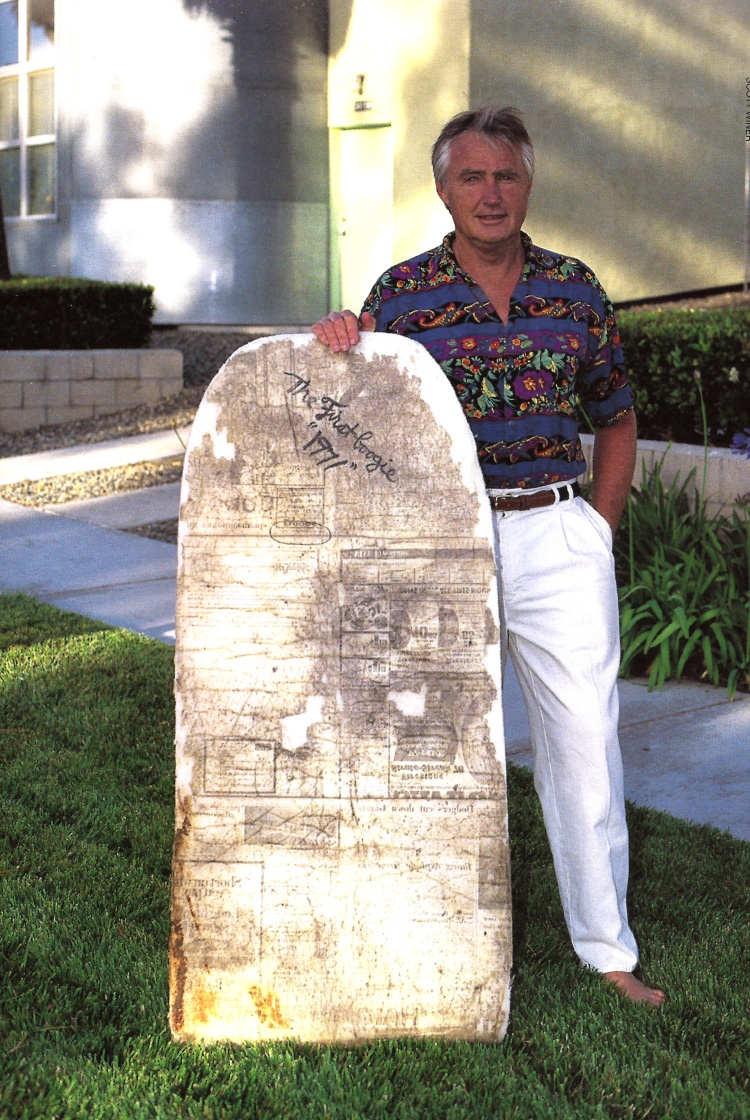
Who was the first person to see your first bodyboard and what did he/she say?
Marchia, my wife, said at the time: "I wanna to try it!" She was excited because, despite being so pregnant, she loved to bodysurf. And she was the second person ever to ride one!
Again, she's eight months pregnant. Now, she's outside, the water sucks out over the reef, leaves her knee-deep standing on it... A four-footer is coming, starts to fill...
She puts the boogie up as a guard, swivels and gets herself on it. Then, poof! She lays forward, and she is swept in! She becomes the first woman boogieboarder. Sorry, but the term "bodyboarder" sucks, and it always has. Sounds like a board they'd use to slide a corpse down into a body bag.
Morey Boogie has changed its ownership throughout the years but have you got any idea of how many units have been sold ever since?
Yes. And you can figure out too.
At our peak, before Kransco (1975 or 1976), on that last summer and working three shifts, we were building 1000 per day. A few years later, out of Tijuana, the foreman told me they were sometimes doing 5000 per day, circa 1980.
Since then, they are made in many other countries. Taiwanese boards, mainland China, Brazil, Malaysia. Who knows where else? Different brands too, of course.
They're certainly in the millions; maybe a couple hundred million. Between 1980 and 2015 - that's 35 years - and at a conservative 100,000 per year from just one company, what's that? Millions.
How did I do? You ask. Although I perhaps could have done more, I helped revolutionize life on this planet. Gave billions of hours of pleasure to millions of people.
I did, and I still am taking part in the awakening of mankind from a nightmare of ignorantly believing in hand-me-down religious superstitions, prejudices, exaggerated old laws that aren't natural laws. Mostly exaggerated hype. Bringing together people of all kinds in the beach playground. I have continuously prayed to be of service and consequently done well.
At 80, I am in decent health, outlived most of my cronies, find five of six kids still living, five grandchildren, and one great-grandchild on the way.
Besides blood relations, there are so many friends I love and young friends I probably will never meet. But the seeds of my life are spread.
My satisfaction? It is like this: one day I was thumbing through a South African surf magazine, and there is a picture of a middle-aged black guy ironing down the edge of a boogie board he was finishing shaping.
The board stand was at the height I would use. He's shaping with a hot iron. I originated that! His stance is mine. The guy is me, essentially, only he's across the world thinking what I thought hundreds of times before.
His posture is the same. So, I knew that he too is a child of the particular winds of change that wafted through me.
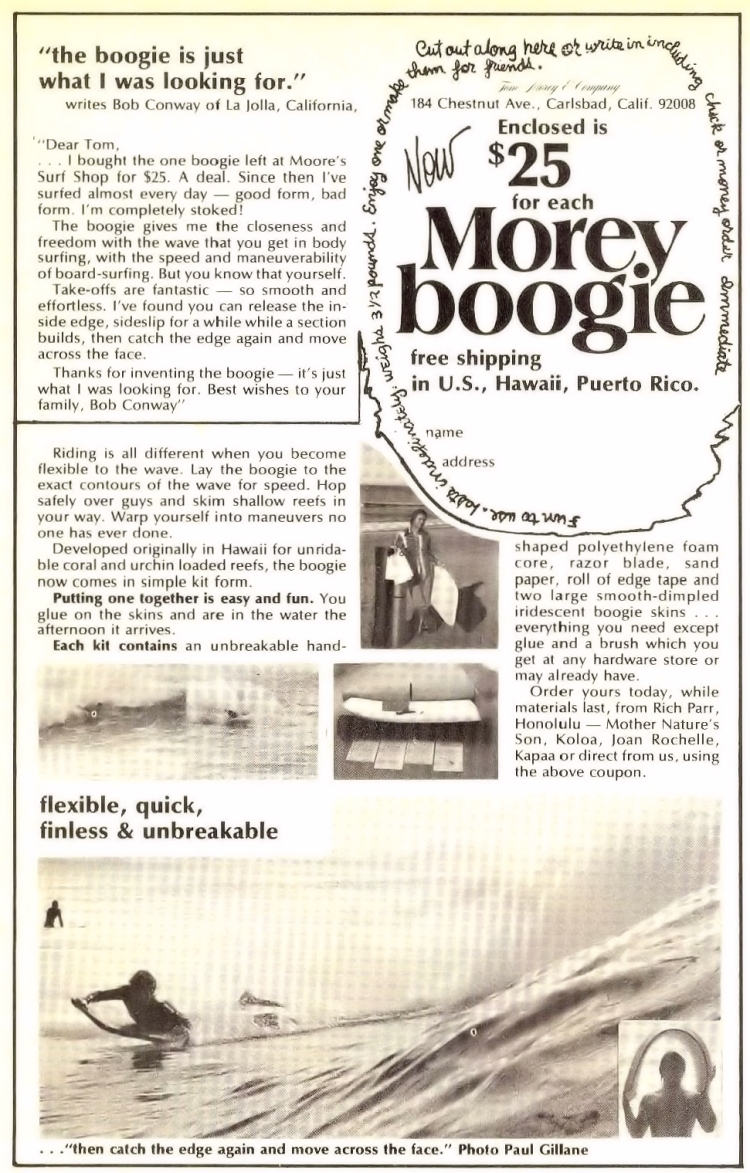
How do you measure success in life?
I will put it this way: for, say, the first third of life, it seems success is measured with respect to peers; how one seems to be doing compared to others.
Second third: I forgot!
In the third segment, I realize how complex and vast life is. My role is so tiny. And yet, my dreams always know where to reach me. I did okay, so dreams are also good. Must be doing some things right.
How do you see the present and future of bodyboarding?
Dow polyethylene foam was the backbone of the industry. Then, the EPA required a different blowing agent be used. Dow complied. It was butane gas.
Thus, one day a truck driver pulls up to a loading dock, opens the door, pulls out a cigarette and lighter and clicks it on. "Snap," "Kaboom". Butane gases, which had been easing their way out of the foam, had built up in the truck and blew the poor guy across the parking lot.
After that, Dow instituted the use of giant spiked rollers to perforate each blank. That is, punched hundreds of holes in them, causing the boards to leak.
Meanwhile, huge Mattel bought big ol' Kransco. Evermore executives, fewer and then zero surfers involved.
Next, offshore companies figured how to use hot melt film adhesives to bond skins to much cheaper - but weaker foam - styrene bead. Great bonds between beads and skins. But bead's bond one to another is very poor.
With ever greater volume involved, today it is about cheap-cheap; targeting the average buyer who, by definition, is below average with respect to the upper half of the market. Thus, quality and design are in a down spiral.
What you can do, though, is buy a cheap one. Rough up the bottom with sandpaper. Buy a 1/8'' plywood door skin, shape it and contact cement it to the bottom. Then, varnish the wood. You'll have a really fast bodyboard.
I know Mike Stewart still makes good boards. Others, you can buy online from Jay and Vicki Reale, and also Jimmy Linville at JL Design, in Oceanside.
I'd like to recommend Morey Boogie, but those people are now a total unknown. Various attempts to reach them over the years have resulted in zero communication.
They have yet to realize the value of having Tom Morey, a prominent name in surfing for 50 years, connected with the Morey Boogie.
In your opinion, how will bodyboard design evolve in the next decades?
Devolve, more than likely. You should concern yourself with your own future. Every one of you - consumers who have paid attention mostly to price, rather than what you'll be getting - have driven quality builders out of business.
If you want something to surf, then figure out how to make it yourself. That's the real kick. Riding what you created.
How do you evaluate the role of the International Surfing Association (ISA) in the promotion of bodyboarding?
I have zero interest in beauty contests, showoffs, tricks, kids reducing their opinions of tricks to what other kids did, showing off for some number on a score sheet.
Surf for your own enjoyment. Learn from the other guys, but avoid judging each other. The best surfer I ever knew, no one would ever have heard of him, today. Nor do I remember his name.
But it was neither Miki Dora, Phil Edwards or Bobby Patterson. It was a guy who only had one eye. Next time you're out there being hot, close one eye and try lining things up.
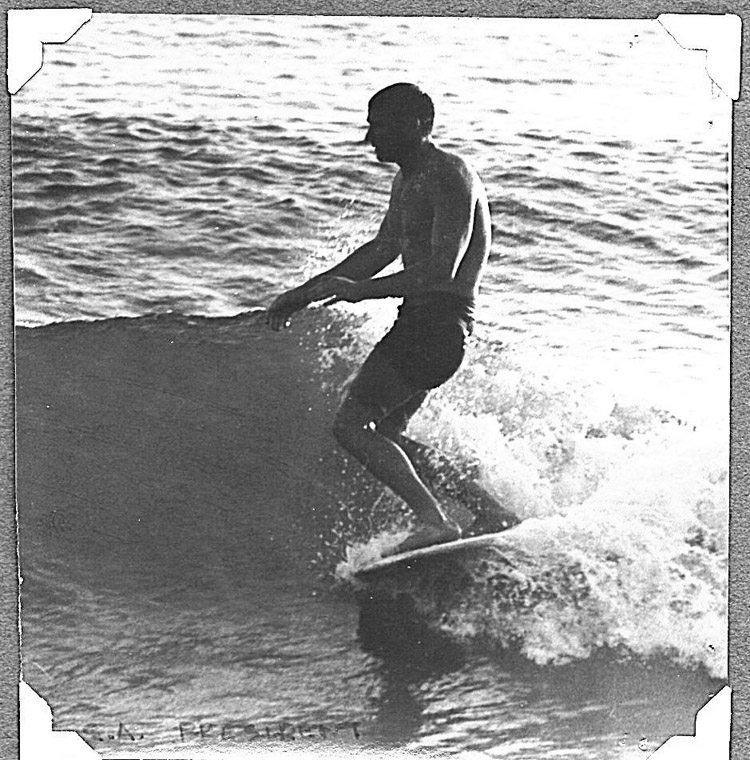
Despite having invented bodyboarding, do you still consider yourself mainly a shortboard surfer?
I am a surfer! Short, long, medium or body, I ride the wave to have fun for myself, not the board to show off. I already have a girlfriend, and I've been married to her for 45 years.
What is the most frequently asked interview question you get?
"Did you ever think it - boogieboarding - would get so big?" Short answer: "No. Of course not." Longer answer: "You watch too many movies. Get a real job and ask questions that will bring you answers that are helpful."
How would you describe your average day?
Up to pee around dawn. Shower, shave. Drink some shower water. Think thoughts of thankfulness (prayers), and go back to bed for a while. Check my email in bed on the iPad, and handle some of it.
Wander to the kitchen, look for leftover snack materials, make a cup of Lipton's regular black tea - half water, half whole milk - and nuke for two minutes. Add a generous spoonful of TJ's clover honey.
Put on some clothes, and drink the tea, my only stimulant for the day. Limit it to one cup usually. Maybe a swig or two of coffee later. But more than that and my thought process is too ambitious. Wheels start spinning too fast.
Let the thoughts of yesterday mix with the awakening opportunities of today; express to myself what I think I need and pray to unknowableness for solutions.
Privately express thanks for solutions to what I had previously thought were impossible problems. Reassure myself the universe is going about it is own schedule, at the proper rate. If it does seem fast enough for me, that's my problem.
Continue working all day, interrupted by bowel movements, phone calls, thirst, hunger, text messages and ever present need to discard, file, place and replace, find, hunt for, store and trash things.
Usually, I'm writing these days, yet I'd rather be building the flying device I know will smoke 'em all.
But it all takes money, and judging by many millionaire friends, they continue their own various paths and usually care more about not losing it than creating what can be awesome.
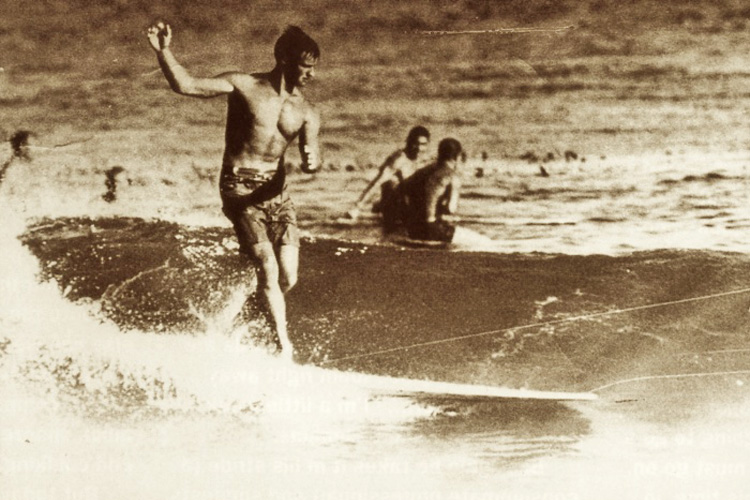
Will we ever read a book with all your life stories in it?
Certainly. I am currently working on that very thing.
What grand message have you got for all bodyboarders around the globe?
If you're any good at surfing, it's because you're still leeching off your parent's support. Mostly your mom's. Stop doing that!
It is better you soon find something that you can make decent income with, and teach yourself how to enjoy doing that. For it is all surfing.
No, no one is going to put you on a magazine cover for doing your job well. But being in the spotlight counts in your mind, mostly because you have been a young sap who has wasted way too much money watching movies and TV, and paid too little attention to how the real world works.
Work and enjoy it!
http://www.surfertoday.com/bodyboarding/11896-tom-morey-the-term-bodyboarder-sucks
viernes, 24 de julio de 2015
martes, 21 de julio de 2015
viernes, 17 de julio de 2015
Wind and Sea to Makaha 1960s
Wind and Sea to Makaha 1960s from REEF MASTER on Vimeo.
jueves, 16 de julio de 2015
martes, 14 de julio de 2015
Alex Knost | 10 Days Extra
Alex Knost | 10 Days Extra from RVCA on Vimeo.
Longboard Era Surfboards by Vintage Surfboards & Collectibles.
Longboard Era Surfboards
Balsa and Fiberglass Surfboards
Newly applied sciences developed during the Second World War had been all but unimaginable in times prior. Brilliant surfers Bob Simmons and his then unrealized protégé’s Joe Quigg and Matt Kivlin, among others, led the charge towards experimenting with new materials.During the latter part of the 1940’S came the ingenious mating of glass fibers wetted out with either epoxy or polyester resins over balsa that forever changed surfboard building. Among the earliest departures from the heavy surfboards was a wood and foam sandwich board built by Simmons during the mid 40s. By decades end, Simmons’ ‘Spoons’ had become a popular choice on California beaches. Circa 1950, Joe Quigg further developed the lightweight fiberglass board with the help of his close friend Matt Kivlin. The boards were referred to as ‘Malibu Chips’.
In late 1949 or 50, Dale Velzy opened what many regard as the first contemporary fashioned surf shop in Manhattan Beach. Shortly thereafter, he opened shops in Hawaii and Malibu. In 1954 Velzy teamed up with fellow board-builder Hap Jacobs to create the Velzy-Jacobs label. Within 5 years they had shops in Venice Beach, San Clemente, San Diego, Newport Beach, Hermosa and Honolulu.
Hobie Alter began making surfboards in 1950, out of his father’s garage in Laguna Beach. He soon recognized an opportunity and opened a surf shop in Dana Point. Perhaps best known for his wave riding skills in huge surf, Greg Noll was also one of the earliest surfboard manufacturers, having commercially offered balsa in the mid 50s.
Others opened their own shops, including Gordon Duane’s Gordie Surfboards in 1956. Worth noting is Bob Shepherd, who learned the craft from Joe Quigg, and started making boards in Hawaii in 1959. Bob’s first boards had an ink stamp ‘Robert Shepherd – Sunset Beach (Hawaii)’. Soon after, he created the short lived label ‘Swimm Boats’.
Foam and Fiberglass Surfboards
It was Dave Sweet who first perfected the manufacturing process and introduced the urethane foam core surfboard in 1956- 1957 as a viable commercial offering. Hobie Alter (of Hobie Surfboards) and Gordon Clark (of Clark Foam) were not far behind Sweet and brought their version to market several of months later.With the advent of polyurethane foam, surfboard building moved into a new epoch. Surfboard blanks could now be molded then sold to surfboard builders, and in volume! The growth in the popularity of surfing, especially so in the early 1960s, was staggering, and foam core surfboards were able to meet that demand.
Popout Surfboards
During this growth period of the sport, several brands of low cost surfboards entered the marketplace and were referred to in derogatory slang as “popouts”. Often capitalizing on well known or famous surfers, shapers and even a catchy place or name, some of the more well known popouts include Velzy, Keoki, Duke Kahanamoku, Malibu and Royal Hawaiian. These boards were most often purchased by beginner or less informed surfers. The boards were typically brightly colored and ornate to cover up the lower grade foams and fiberglass materials. The fins were often made of laminated mixed woods. Popouts accounted for only a very small market share and were typically sold through department and sporting goods stores outside of the mainstream circle of dedicated surf shops.Popout boards were invented in 1959 by Robertson – Sweet Surfboards. A partnership between Hollywood actor, Cliff Robertson and Roger Sweet, the brother of foam surfboard manufacturing pioneer Dave Sweet.
A List of Popout Labels Include:
Acme, Bohemiam, Surfboards by Dale, Dextra, Diwain, Hawaiian Pipeline, Hawk, Healthways, Islander, Duke Kahanamoku, Keoki, Keyo, Lari Kai, Mako, Malibu, Newporter, Pacific Beach, Pacific Plastics, Phil, Plastic Mart, Robertson-Sweet, Royal Hawaiian, Sea-Jay Surfer, Seaking, Sealand, Seven Seas, Sportflight, Sportsways, Sting Ray, Surf City, Surf King, Surf Queen, Ten Toes, Tiki, Titan, Tyro, Vagabond, Velzy, and VenturaModel Surfboards of the Mid to Late 1960s
Bing Surfboards
- Donald Takayama Model
- David Nuuhiwa Noserider
- David Nuuhiwa Lightweight
- Pipeliner
- Pipeliner – Island Semi
- Pipeliner – Gun
Challenger Surfboards
- Semi Aggressor
- Bump
- Aggressor
- Affectianado LTD
- Santa Cruz
- Caster
Con Surfboards
- Wingnose
- Multi Board
- Baja
- Competition
- Ugly
- Steve Biggler Classic
- Claude Codgen – C.C. Rider
- Claude Codgen – C.C. Leightweight
Dave Sweet Surfboards
- Noserider
- East Coast Agressor
- Step Model
- Hustler
- Flexer
- Speedster
Del Cannon Surfboards
- Total Involvement
- Versatile
- Swift
- Ego Builder
Dewey Weber Surfboards
- Herold Iggy Model
- Concave
- Gun
- Pre Performer
- Performer
- Herold Iggy 67 Model
- Feather
- Stylist
- Professional
Gordie Surfboards
- Mark V
- Noserider
- Lizard
- Middleweight
Gordon & Smith Surfboards
- Mike Hynson Redfin
- Mike Hynson Redfin Gun
- Nose Riding Model
- Stretch
- Midget Farrelly Stringerless
- Skip Frye Model
- HY I
- HY II
- Hot Curl
Greek Surfboards
- Eliminator
- Liquidator
- East Coast Special
- Maui Model
- Maui Pintail
- Outlaw
- Newport Special
- The Association
- East Coast Eliminator
Hansen Surfboards
- Mike Doyle
- 50/50
- Powerflex
- Master
- Competitor
- Superlite
Harbour Surfboards
- Banana Model
- Trestle Special
- Cheater – Step Deck
- Banana 67 Model
Hobie Surfboards
- Phil Edwards
- Nose Rider
- Dick Brewer – Gun
- Corky Carroll
- Gary Propper
- Multi Board
- Joyce Hoffman Model
Holmsey Surfboards
- Sidewinder
- Kim Nielson Model
Jacobs Surfboards
- Donald Takayama
- Donald Takayama – Step Deck
- 422
- Lance Carson
- New Shape
- Mike Purpus Model
Morey – Pope Surfboards
- Snub
- Peck Penetrator
- Blue Machine
- AAA Eliminator
Greg Noll Surfboards
- Slot Bottom
- Miki Dora – Da Cat
- Duke Kahanamoku Nollrider
- Duke Kahanamoku Hawaiian Nollrider
- Duke Kahanamoku East Coast Nollrider
- George Downing
- George Downing Gun
- Honolulu, Hawaii
- Miki Dora – Da Cat – Fin Box
- Stemwinder
O’Neill Surfboards
- Danny Anderson Model
- Intruder
- Intruder II
Rick Surfboards
- Noserider
- Barry Kanaiaupuni
- Dru Harrison Improvisor
- UFO
- D.B. Pintail
Surfboards Hawaii
- Buzzy Trent Gun
- Bonzai Board
- Model A
- Stylist I
- Stylist II
Surfboards La Jolla
- Superboard
- Twin Pin
- Vibration Model
Tanaka Surfboards
- Ernie Tanaka Model
- Featherweight
Velzy Surfboards
- The Wedge
- The Bump
- Pig
Windansea
- Cheroot
- Panatella
- Invincible
- El Producto
- Sandpiper
- Tiparillo
- Equalizer
- VIP Model
Yater Surfboards
- Pat Curren Gun
- Full Gun Model
- Spoon
- Nose Specializer
- North Shoreline
Major Manufacturers During the Longboard Era of the 1950s and 1960s Include:
ACME, A.J. Surfboards, Allen, Steve Angus, Aqua Jet, Atlantic, Atlas, Aussie, Austin – Baird, Australian Surf Shop, Awareness, Barland, Bahne, Baja, Banzai, Dick Barrymore, Bay Surfboards, Beachcomber, Bellaire, Bendiksen, Bennett, Bing, BJ Surfboards, Blaker, Blue Cheer, Bohemian, Brad, Bragg, Brandon, Brown, Buck, Bunger, Boards by Bunn, Joey Cabell, Campbell, Del Cannon, Carbonell, Caster, Catri Surfboards, Central, Challenger, Challenger Eastern, Channin, Channin – Diffenderfer, Chapman Surfboards, Collier, Con, Copeland Surfboards, Corbin, Country, Creative Design, Creative Surfboards, Crestwood, Crown, Cunningham, Pat Curren, Surfboards by Dale, Dana, Duke Dana, Dale, Daytona Beach Surf Shop, DeGroot & Mason, Deese, Chuck Dent, Design I, Dextra, Mike Diffenderfer, Diwain, George Doolittle,East Coast Surfboards, Carl Ekstrom, Larry Felker, Flaherty, Fred Surfboards, Fry, Fuhrmann, Bill Fury Surfboards, Galt, Gordie, Gordon & Smith, Greek, Tom Hale, Jack Haley, Hang 5, Hannon, Hansen, Harbour, Haut, Hawaiian Pipeline, Hawk, Hawley, Hayden, Healthways, Hickey, Hobie, Holden, Hollinger, Holmsey, Paul Hunt, Hydroplane, Ike, Inter-Island, Islander, Jacks, Jacobs, Jeffrey – Dale, Jensen, Duke Kahanamoku, Kelp, Keoki, Keyo, King, Laguna Beach, Lari Kai, Joe Larkin, Leedy, Liddle, Lightning, Lindsey, Lisardi, Lyman, Makaha, Mako, Malibu, Manatee, Marlin, Maryland, Matador, Maui Surfboards, Micris, Miller, Mitchell Brothers, Mobley, Monarch, Morey, Morey – Pope, Moselle, Moyer, Mickey Munoz, Native, Nelson – Ekstrom, Newporter, Norsk, Greg Noll, David Nuuhiwa, Oahu, Oceanside, Ole, Olson, Olympic, O’Neill, OP, Owl, Pacific Beach, Pacific Coast, Pacific Beach, Petrillo, Phil, Pismo Beach, Plastic Fantastic, Joe Quigg, Ramsey Jay, Redondo Surf Shop, Reef Surfboards, Dusty Rhodes, Rible, Johnny Rice, Rick, Roberts, Robertson – Sweet, Rogers, Ron Surfboards, Ron John Surf Shop, Royal Hawaiian, Russell, Safari, San Diego Surf Shop, San Juan, Schuck, Scofield, Sea Cross, Seaking, Shaw, Shool, Skag, Ski & Dive, Small & Neves, Soul, Southbay, Southcoast, South Shore, Sportflight, Sportsways, Stewart, Sting Ray, Surf Africa, Surfboard House, Surfboards Australia, Surfboards California, Surfboards East, Surfboards Hawaii, Surfboards La Jolla, Surfboards Miami, Surfboards San Clemente, Surfboards Seaside, Surfco – Swarts, Surf Jet, Swarts, Sweeney, Dave Sweet, Donald Takayama, Tamarack, Ernie Tanaka, Ten Toes, Thrailkill, Tiki, Tilton, Titan, Travis, Vagabond, Sonny Vardeman, Velzy, Ventura Surf Shop, Voo Doo, Wallace, Wardy, Wave Riding Vehicles, Dewey Weber, Wetzel, Bob White, White Owl, Wilderness, Wilken, Windansea, Winterburn, Gordon Woods, Yater, YountFor loads more information on vintage longboard era surfboards from the 1940s through 1967 and beyond, including hundreds of photos, each with detailed descriptions and values, see the chapter Longboard Era: Wood and Fiberglass and Foam and Fiberglass in The Ultimate Guide To Vintage Surfboards & Collectibles.
Buy- The Ultimate Guide To Vintage Surfboards & Collectibles.
http://theultimateguidetovintagesurfboardsandcollectibles.net/longboard-era-surfboards/
jueves, 9 de julio de 2015
miércoles, 8 de julio de 2015
martes, 7 de julio de 2015
lunes, 6 de julio de 2015
sábado, 4 de julio de 2015
MASTER TYLER HATZIKIAN Faux Chip
Faux Chip from Tyler Surfboards on Vimeo.
tyler surfboards Throttle Model Description
Throttle Model Description from Tyler Surfboards on Vimeo.
Listen to Devon Howard briefly explain why he loves the new Throttle Model. Surfers: Devon Howard, Kick, Josh Gilberts. Footage by Kiyo Okada and Graham Edkins
How To Road Trip
How To Road Trip from Samuel Glazebrook on Vimeo.
A short film about travelling and surfing in Cornwall, UK.
An independent film directed, shot and edited by Samuel Glazebrook.
Please feel free to donate via the 'tip jar' to help support me to make
more films. Featuring
Surfing & narration
Samuel Glazebrook
Michael Lay
Richard Balding
John Eldridge
Also surfing
James Parry
Jack Whitefield
Josh Daniel
Music by
The Funk Ark
Radical Face
Absofacto
Travers Alder
Illustration & lettering
Liz Tregaskis
world log riding exhibition sydney australia
world log riding exhibition sydney australia from australian surfing resurrection on Vimeo.
Syrf expression you arrive Kegel wyldest tyrn
Robbie Warden jazz lord emmission Lachlan Leckie smiles Babe Rainbow
singing Wild Things gallery.
A Super8 and 16mm fylm by Dean Darby for the Australian Surfing
Resurrection. Thankyou to Just Stay Coolo and OK-WHITELANE for
additional action footage.The World Log Riding Exhibition - presented by the Australian Surfing Resurrection and Wild Things gallery; featured in and supported by Foam Symmetry magazine.
miércoles, 1 de julio de 2015
Alex Knost | Noosa '15
Alex Knost | Noosa '15 from RVCA on Vimeo.
Suscribirse a:
Comentarios (Atom)












